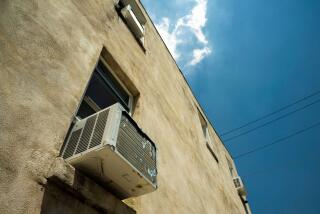A Current Event
- Share via
SYLMAR — Just call Los Angeles the air-conditioned city.
With the mercury bobbing between 95 and 105 degrees, the city’s Department of Water and Power reported the highest energy usage of the year at 4:24 p.m. last Monday--5,320 megawatts per hour.
That’s a lot of lightbulbs--in fact, that’s about 53.2 million lightbulbs burning for an hour.
Just how all that power gets to all those refrigerators, alarm clocks, personal computers, stereo systems--and most importantly these days, air conditioners--is John Phipps’ concern. Phipps, a supervising operator of the Sylmar Converter Station, is the lord of light and the king of cool.
“We’re running just a little bit below capacity” and about 25% over the station’s usual output, said Phipps on the day the record was set. “We’ve been like this since . . . the latest heat wave started.”
The Sylmar Converter Station, just north of the Los Angeles Reservoir on Sepulveda Boulevard, is the city’s electric socket. The plant does not generate power on its own, but rather receives power from generating stations like Castaic Power Plant, 22 miles north of the city, the Owen Gorge power plants in the eastern Sierra Nevada and Hoover Dam, along the Colorado River in Black Canyon.
In the summer, most of the city’s electricity is generated in Celilo, Ore., where several dammed rivers whirl turbines and create hydroelectric power, Phipps says. That power then courses through cables strung over 848 miles, past Reno, Carson City, Lake Tahoe, Owens Dry Lake and Mojave to the northeastern edge of the San Fernando Valley.
A steel-caged garden of machines outside the plant buzzes like a planet of robotic bees. Phipps warns visitors not to touch anything.
“We treat everything as if it’s hot . . . electrically charged,” he said.
Most of the gargantuan structures are there to prevent overheating of other essential machinery and to reduce “noise,” both the kind humans hear and powerful microwaves and magnetic fields, which disrupt everything from cellular telephones to garage door openers, Phipps said.
Inside the plant, Phipps walks to a control board through a room of computers arrayed in flickering walls. Digital readouts show exactly how much electricity is going where. Behind the control panel is a door leading to the valve hall--a set of three rooms that could have come straight off the Starship Enterprise.
A wide suspended walkway divides two rows of immense converters humming with enough power to charge most American cities. These machines are the heart of the plant. Direct current electricity passes into the converters, because it is a more efficient way to send electricity long distances than alternating current which would lose about 15% of its wattage during the trip from Oregon, Phipps said.
The Sylmar station then converts the electricity to a usable AC current and decreases the voltage from 500,000 to 230,000 by routing the energy through several valves.
Flashing through wires at the speed of light, AC current exits the station and streams to a switching station where it is divided among several transmission lines carrying 34,500 volts each. From there it flows to a distributing station that further divides it, sending 4,800 volts to several transformers in Los Angeles neighborhoods.
From the pole-top transformers, each business receives 240 volts and each household 120 volts of electricity--powering air conditioners and draining bank accounts citywide.
More to Read
Inside the business of entertainment
The Wide Shot brings you news, analysis and insights on everything from streaming wars to production — and what it all means for the future.
You may occasionally receive promotional content from the Los Angeles Times.










